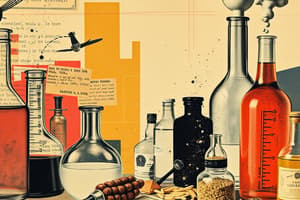Podcast
Questions and Answers
What is the classification of matter?
What is the classification of matter?
One way chemists classify matter is based on its purity.
What is a pure substance?
What is a pure substance?
Matter that has only 1 set of chemical and physical properties.
Give an example of a pure substance.
Give an example of a pure substance.
Pure water has the exact same chemical and physical properties under the same conditions.
What are pure substances divided into?
What are pure substances divided into?
What is a compound?
What is a compound?
Provide examples of compounds.
Provide examples of compounds.
Compounds only have one set of properties.
Compounds only have one set of properties.
Compounds can be separated by physical processes.
Compounds can be separated by physical processes.
How can compounds be separated?
How can compounds be separated?
Give an example of compounds being separated.
Give an example of compounds being separated.
What are elements?
What are elements?
Provide examples of elements.
Provide examples of elements.
What is a mixture?
What is a mixture?
Mixtures can always be separated by physical means.
Mixtures can always be separated by physical means.
What is a heterogeneous mixture?
What is a heterogeneous mixture?
Provide examples of heterogeneous mixtures.
Provide examples of heterogeneous mixtures.
What is a homogeneous mixture?
What is a homogeneous mixture?
Provide an example of a homogeneous mixture.
Provide an example of a homogeneous mixture.
What are solutions?
What are solutions?
Provide examples of solutions.
Provide examples of solutions.
What are colloids?
What are colloids?
Provide an example of a colloid.
Provide an example of a colloid.
What is a suspension?
What is a suspension?
Provide examples of suspensions.
Provide examples of suspensions.
Flashcards are hidden until you start studying
Study Notes
Classification of Matter
- Matter is classified based on purity into pure substances and mixtures.
Pure Substance
- Defined as matter with a single set of chemical and physical properties.
- Example: Pure water maintains identical properties under consistent conditions.
- Divided into compounds and elements.
Compounds
- Formed by two or more elements that are chemically bonded.
- Have one unique set of properties and cannot be separated by physical processes; separation requires a chemical reaction.
- Example of separation: Water can be split into hydrogen and oxygen via electrolysis.
- Pure substance examples include carbon dioxide (CO2), water (H2O), salt (NaCl), and sucrose (C12H22O11).
Elements
- Consist of a single type of atom.
- Cannot be separated by physical or chemical methods.
- Examples include carbon, helium, and gold.
Mixture
- Comprises two or more pure substances mixed together while retaining their individual properties.
- Mixtures can be separated by physical means.
- Example of a physical separation method: Using magnets to separate iron from a sand-salt mixture.
- Mixtures vary in purity.
Heterogeneous Mixture
- Characterized by an uneven distribution of components.
- Considered very impure.
- Examples include sand, granite, wood, Chex Mix, chocolate chip ice cream, milk, and blood.
Homogeneous Mixture
- Features an even distribution of components, appearing uniform.
- Parts are not visible to the naked eye.
- Examples: Salt water is mixed at the atomic level and can be separated by physical means.
Solutions
- A type of homogeneous mixture that does not scatter light.
- Created when substances are fully dissolved in pure water.
- Easily separated by distillation or evaporation.
- Examples include sugar water and salt water.
Colloids
- A class of solutions, described as substances trapped within another substance.
- Identified by the Tyndall effect, which is the scattering of light.
- Example: Air trapped in fat molecules within whipped cream; also found in milk.
- Other examples include fog, smoke, glue, gelatin, and mayonnaise.
Suspension
- Contains larger particles compared to solutions.
- Components can be evenly mixed mechanically but will settle over time.
- Examples: Oil and water, water and sand.
Studying That Suits You
Use AI to generate personalized quizzes and flashcards to suit your learning preferences.




